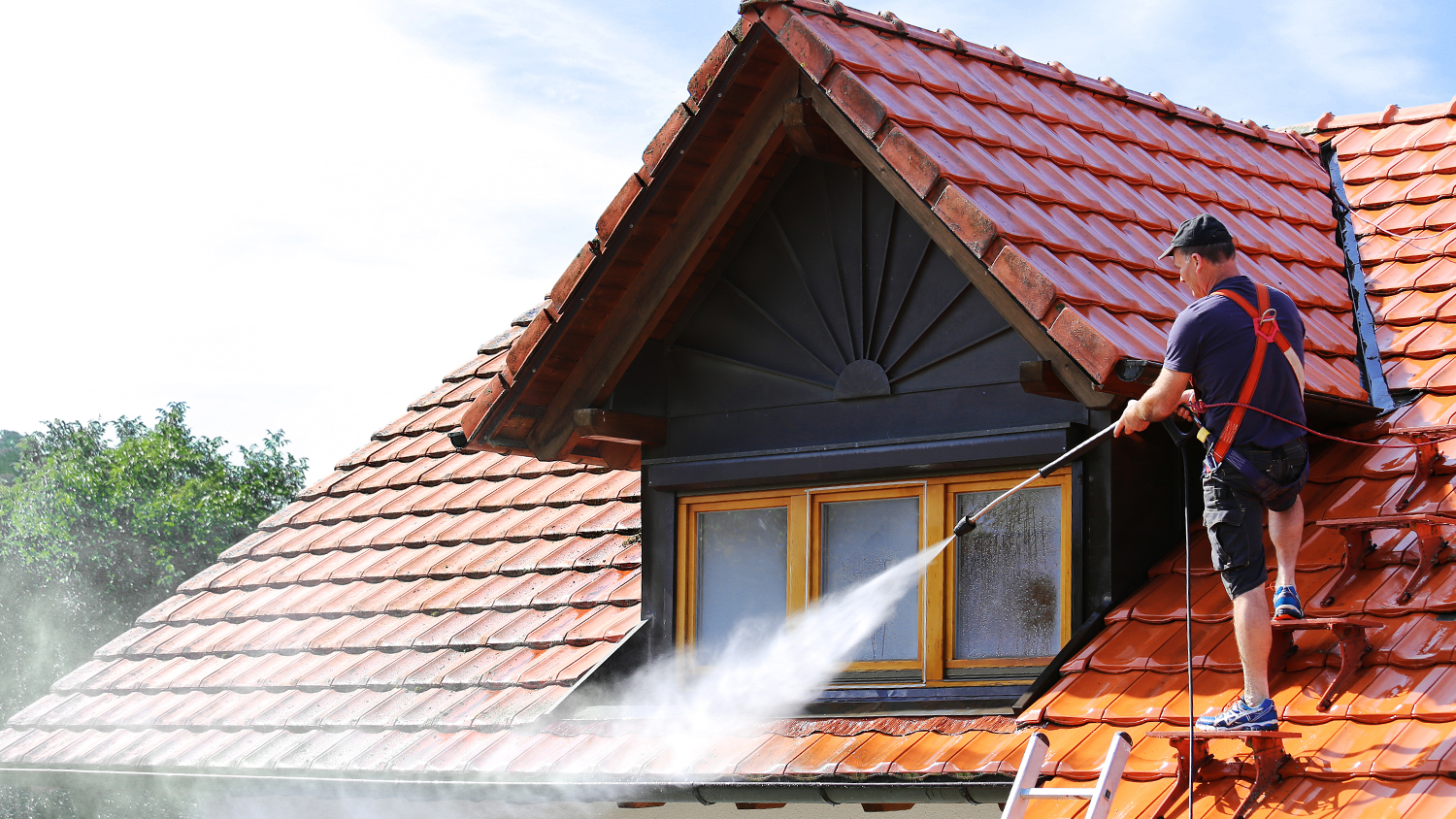
Roof cleaning costs may not be as high as you think. Learn why the size and type of your roof, as well as the cleaning method, aren’t the only cost factors.
If you aren’t afraid of heights, you can tackle this task on your own


Algae growth on rooftops isn’t just an eyesore, it can also cause damage if left unchecked. Fortunately, removing algae from your roof can be a manageable task with the right tools and a bit of effort—as long as you aren’t afraid of heights. If you don’t like the idea of climbing on your roof, you can always hire a professional roof moss remover near you. In this guide, we’ll explore the steps you can follow to safely and effectively remove algae from a roof.
Because you will be climbing on a roof with slippery algae on it, you need to take safety seriously. Before kicking off this project, equip yourself with the essential safety gear, such as a well-fitted safety harness, impact-resistant goggles, and sturdy, slip-resistant footwear.
First, get your cleaning product ready. Follow the specific instructions provided by the manufacturer to prepare the algae or moss cleaner solution. Alternatively, if opting for a DIY solution, blend water and vinegar in the recommended proportions in a sturdy bucket for application.
Before commencing the cleaning process, meticulously clear the roof of any loose debris, such as leaves, twigs, or larger fragments using a soft-bristled brush or a reliable leaf blower. This step leads to an unobstructed cleaning process which will save you time later, and help you do a better job.
Once you have a clear roof, you can apply the cleaner. Use a sprayer or a soft-bristled brush to uniformly distribute the prepared cleaner across the roof’s surface. It’s a good idea to initiate from the lower sections and work upwards to prevent streaking or uneven distribution.
Allow the applied cleaner to sit on the roof for the specified duration outlined in the product instructions. This waiting period gives the solution a chance to effectively permeate and loosen the algae, facilitating easier removal.
Employ a soft-bristled brush or, if using a pressure washer, adjust it to a low-pressure setting to delicately scrub or rinse the roof. Always maintain a downward motion during cleaning to avoid dislodging or damaging shingles.
Post-cleaning, thoroughly rinse the roof using a garden hose to eliminate any remaining cleaner residue or dislodged algae. You need complete removal to prevent potential streaking or future growth.
Once you are done, conduct a thorough inspection of the roof surface for any missed spots or persistent algae patches. If needed, repeat the cleaning process, exercising caution to avoid overly vigorous scrubbing that could compromise the roof’s integrity.
Since you’re already on the roof, consider applying a protective treatment or strategically installing zinc strips along the roof's ridges to impede future algae growth. Additionally, trim nearby trees to reduce excessive shade and moisture accumulation on the roof.
Dispose of any used cleaning materials responsibly, ensuring they don’t pose a threat to surrounding vegetation or the environment. Leave the area clean and tidy upon completion of the project.
When considering removing algae from your roof, the DIY approach presents advantages in cost-effectiveness and control over the process. Undertaking the task yourself means potential savings on labor costs, as you'll primarily incur expenses for tools, supplies, and cleaning solutions. However, opting for the DIY route demands a significant investment of time, physical effort, and careful adherence to safety precautions, as working on a roof can pose risks if proper measures aren’t followed.
You can expect to spend about $500 to $1,000 on this project with the bulk of that expense coming from a pressure washer. If you already own, can borrow, or can rent a pressure washer, this DIY is actually really affordable.
On the other hand, hiring a professional for algae removal offers distinct advantages. Professionals bring expertise, specialized equipment, and a depth of experience to the task. While the upfront costs are higher due to labor charges and service fees, this approach ensures a more efficient and often quicker result.
You can expect to spend between $295 and $621 to hire a professional. Professionals also minimize risks associated with the task, ensuring safety and potentially extending the longevity of your roof. It not only saves you time and physical effort but also provides peace of mind knowing that the job is handled by experts.
From average costs to expert advice, get all the answers you need to get your job done.

Roof cleaning costs may not be as high as you think. Learn why the size and type of your roof, as well as the cleaning method, aren’t the only cost factors.

Get clear answers on ice dam removal cost, including average prices, cost factors, and ways to save. Learn what impacts your total and how to budget.

Discover the cost to pressure clean a roof, including average prices, key factors, and tips to help you budget and maintain your roof efficiently.

Learn more about the pros and cons of roof cleaning to decide whether your home’s roofing material can benefit from removing mold, moss, and algae.

Not sure who to hire to clear ice dams from your roof? A roofer or handyman might be able to help, but a snow removal specialist is your best option.

Did you know roofs of all types can benefit from a cleaning? Using this guide, you’ll understand the benefits of regular roof cleaning and why it’s best to hire a prof.